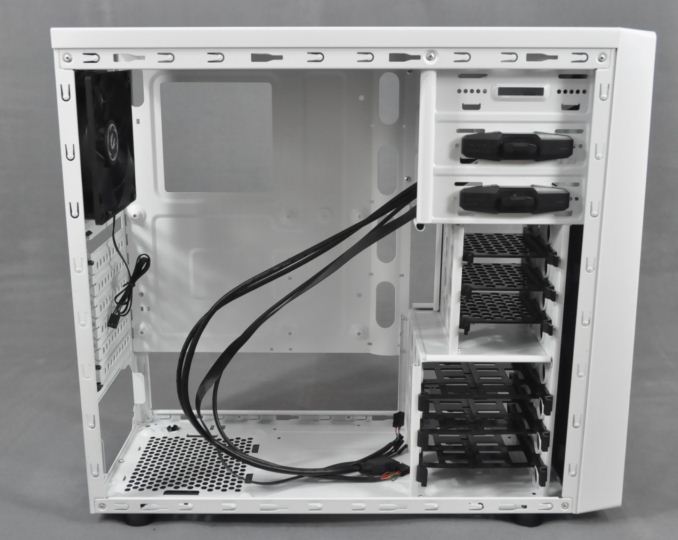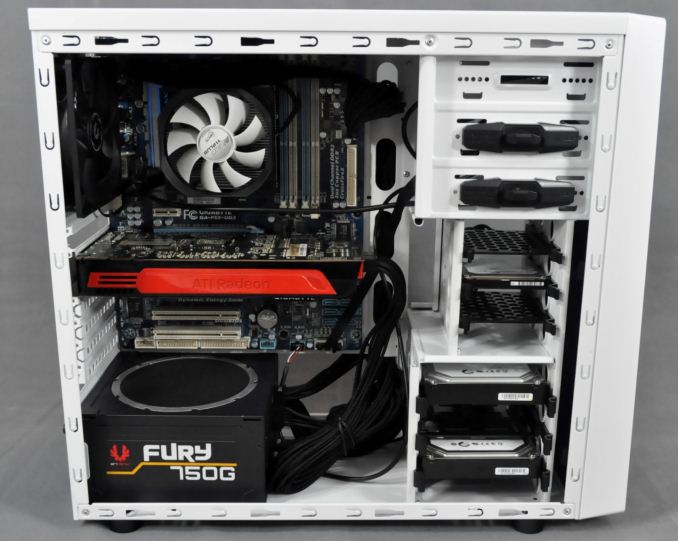BitFenix Neos Case Review
by E. Fylladitakis on January 21, 2015 9:00 AM EST- Posted in
- Cases/Cooling/PSUs
- bitfenix
- Case
BitFenix Neos Interior
The interior of the BitFenix Neos is relatively simple, nearly as much as a generic low cost Mid-Tower case. Everything inside the case is bolted together – no bays or metallic parts are removable. The motherboard tray is sizable enough for a typical ATX motherboard, with an opening behind the CPU area for the installation of CPU coolers.
Of course the size and location won't work for anyone with a motherboard that does not have its CPU socket right at the center of the upper left square area formed by the four screws, which will affect more than half of the motherboards available today, forcing the users to remove them in order to change the CPU cooler. On the other hand, those who rarely change out CPU coolers will be able to install the cooler before installing the motherboard. Note that the case is narrow as well, and CPU coolers taller than 150-155mm are not going to fit. Furthermore, instead of using brass motherboard stand-offs, the tray itself is embossed to form screw fixings for the motherboard. This can make assembly more convenient at times at the cost of some flexibility.
Across the right edge of the motherboard tray, there are four holes for the routing of cables. A fifth hole is present at the top left corner of the tray as well. None of these holes have any rubber grommets and all of them are barely large enough for an ATX 24-pin connector to fit. As there is virtually no clearance behind the motherboard tray for the routing of cables, the right section is elevated for the thick ATX cable to fit. Unfortunately, the use of a couple of PCI Express cables and SATA cables will require more than a little force to close the side panel.
There are three drive cages in the Neos. The top cage is for two 5.25" devices, which can be secured using the plastic locks. The middle cage is narrow, slightly increasing the clearance for one GPU card up to 310mm, and holds three trays for 2.5" devices. Finally, the bottom cage is for three 3.5" devices, but its trays can be used for 2.5" devices as well. For 3.5" devices, no tools are required, but in either case a screwdriver is necessary for the installation of a 2.5" drive.
The motherboard expansion slots are perhaps the greatest issue of the Neos. We have not seen the use of perforated non-reusable covers in a long time, but here they are, the removal of which is permanent and frequently leaves nasty dents behind. Above the expansion slots, the only stock fan of the case can be seen, a black 120mm fan. Take note that due to the narrowness of the case, there is no clearance to install a liquid cooling radiator wider than the fan itself here.
There is plenty of room for any kind of power supply, yet we advise against the installation of a unit longer than 160mm, as the fan opening is small and the displacement of the fan backwards will result in partial blockage, which is a problem with PSUs as it can leave critical components without sufficient cooling. The PSU sits on embossed metallic feet formed from the case panel itself. For this review, BitFenix supplied us one of their Fury 750G PSUs that has individually sleeved cables and is a perfect fit for the Neos.
As exhibited in the pictures of our test build, the interior of the BitFenix Neos is relatively comfortable to work with but can easily end up looking messy, as the cable management options are very limited. The only pathway for the routing of cables, to the right of the motherboard tray, becomes congested with just the thick 24-pin ATX cable going through it. The placement of the hole at the top left corner of the tray appears to have been done with little thought, as a typical motherboard blocks it entirely, leaving no room for a CPU power cable to fit through. There is enough space to comfortably work with the connectors and cables of the 2.5" and 3.5" drives though.
To summarize the component limitations once again, CPU coolers taller than 150mm are not recommended and a single 310mm GPU card may be installed. 160mm long PSUs are strongly advised. The radiators of AIO liquid cooling systems cannot be installed anywhere as well, and the routing options for cables are lacking. Given the price, these flaws could be overlooked provided the performance and other features prove desirable, so let's move on to our testing.


















54 Comments
View All Comments
Oxford Guy - Wednesday, January 21, 2015 - link
You can get a case for $25 that can be used for a low wattage system. Why spend so much on this? It doesn't have good cable management, etc.SleepModezZ - Wednesday, January 21, 2015 - link
In the shop that I usually buy from the cheapest midi/mini case (for full ATX-motherboards) is 33€ (LC-Power 3001B). Neos (without a window) is 41€. Scrolling the list down from cheapest to more costly, the Neos is the first to give some aesthetic pleasure because its color options. That could decide it for some. You can choose a case that fits the room it will be in. Cable management is not really so important if you have a low wattage system in a windowless case. (I don't really understand the window option on a case like Neos.)E.Fyll - Thursday, January 22, 2015 - link
A lower thermal load would yield correlative results, just at a lower magnitude and over a significantly longer period of time. That is why every comparison of cases using either the 850W and 400W load charts always ends up the same. Regardless of the thermal load, given that we are talking about a passive load, if case A is better than case B, it will always be better than case B - only the magnitude of the results changes.We are using the 400W load only because there are some cases (like this one) that cannot handle a very high thermal load at all without starting a fire. With the 400W load requiring a time of at least seven hours to give usable results, testing with a lower load is unfeasible - it would take days and I cannot keep the ambient conditions stable for that long. Furthermore, a very low load would bring the results of many cases very close together, making them look virtually identical, because of the shrinkage of the scale. My equipment can tell the difference between 41°C and 42°C, but not between 20°C and 20.02°C.
SleepModezZ - Thursday, January 22, 2015 - link
Thank you for your answer - and for the review. You are right that it makes sense to test in the way you do. The problem is more in the conclusions that seems to be derived from that - or maybe just the emphasis on that one fact. At a low thermal load the case will still be worse thermal wise than the bigger and more expensive comparisons - but in practice the difference won't matter much. Other factors will easily overrun that drawback for a potential buyer who is not interested in building a gaming rig into the case.It seems that you did not like the looks of the case. I have not seen it in person so I can't make a comment. Still, it has several color options to choose from whereas probably every else case in the same form factor and price group comes without such choice. I, for one, would easily pay 50% more (or accept other drawbacks) to get a case in the most pleasing color option. It will be a part of the furniture for some years so the exterior appearance, in the context of the room where it will be sitting in, is very important. I don't know if BitFenix was the first to offer cases with color options - more than a black and a white option, or a black and an aluminium/silver option - but they are currently very prominent in that - and I really appreciate that.
Antronman - Wednesday, January 21, 2015 - link
Scorching review. All you need is some obscene language and I'd think Chef George Ramsay wrote this.Antronman - Wednesday, January 21, 2015 - link
Fuck Gordon Ramsay wtf was I doingmakerofthegames - Wednesday, January 21, 2015 - link
tl;dr version: BitFenix finally fucked one up.wbwb - Wednesday, January 21, 2015 - link
This is a fine-looking, solidly built case for a basic PC with a quad core CPU and a single GPU, i.e. a 450 watt system. I built one last month. Not every case has to be designed to support overclocking and radiators or monstrous heatsinks. If you want that, there are plenty of other cases to choose from, and stop kidding yourself, you're not going to buy a $60 case anyway.chlamchowder - Wednesday, January 21, 2015 - link
The problem is, there are $60 cases (Corsair 200R, NZXT Source 220, and probably some others) that can take radiators or bigger heatsinks, and look like decent options even for overclocking.If you want to overclock, and want radiators/big heatsinks, and can get a case that supports that for $60 or even less, why not do that?
lazymangaka - Saturday, January 24, 2015 - link
If you know you want to overclock and think the possibility of radiators or big heatsinks is in your future, you should probably choose a case that reflects that.This case isn't for that. It doesn't (to the best of my knowledge) claim to be that. This is the sort of case for the build you do for a parent, sibling, or significant other that is built once then not touched for years. The sort of build where the looks of the case are more important than the convenience of the cable management.